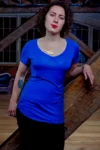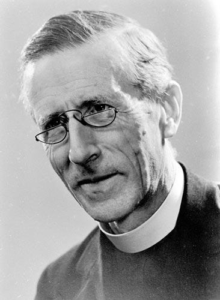The Heart of Matter: Pierre Teilhard de Chardin on Bridging the Scientific and the Sacred
SCIENCE - SPIRITUALITY, 15 May 2023
Maria Popova | The Marginalian – TRANSCEND Media Service
“Blessed be you, mighty matter, irresistible march of evolution, reality ever new-born; you who, by constantly shattering our mental categories, force us to go ever further and further in our pursuit of the truth.”
“Matter delights in music, and became Bach,” Ronald Johnson wrote in a stunning prose poem. How it did — how we became, in the poetic words of the physicist Richard Feynman, “atoms with consciousness… matter with curiosity” — may be the supreme mystery of existence. And yet here we are, each of us having triumphed over staggering odds in order to exist at all, all of us moving through the sliver of spacetime we have been allotted as material creatures animated by rich spiritual lives, governed by entropy, yearning for eternity.
Few people have given voice to this existential tension between our materiality and our spirituality more beautifully than the French paleontologist, Jesuit priest, and philosopher Pierre Teilhard de Chardin (May 1, 1881–April 10, 1955) — an uncommon bridge figure between the scientific and the sacred, who felt deeply at home in the world of gravity and gluons, and took part in the discovery of the Peking Man fossil that helped illuminate the evolutionary history of our species, but who also thought deeply and wrote beautifully about the most immaterial and transcendent regions of our experience.
An epoch before the poetic physicist Alan Lightman introduced the notion of spiritual materialism, Teilhard de Chardin took up these questions in The Heart of Matter (public library), titled after his long autobiographical essay chronicling his spiritual awakening to the wonder of reality and materiality.
In language of ravishing vibrancy and vitality, he contours his offering:
I shall try… to show how, starting from the point at which a spark was first struck, a point that was built into me congenitally, the World gradually caught fire for me, burst into flames; how this happened all during my life, and as a result of my whole life, until it formed a great luminous mass, lit from within that surrounded me.
This becoming, he argues, is available to every person fully awake to their own life and the life of the Earth:
Within every being and every event there was a progressive expansion of a mysterious inner clarity which transfigured them… Crimson gleams of Matter, gliding imperceptibly into the gold of Spirit, ultimately to become transformed into the incandescence of a Universe that is Person… The Diaphany of the Divine at the heart of a glowing Universe, as I have experienced it through contact with the Earth — the Divine radiating from the depths of a blazing Matter.
At the heart of this luminous totality, Teilhard de Chardin places what he calls “the sense of plentitude.” He writes:
To be completely at home and completely happy, there must be the knowledge that “Something, essential by nature” exists, to which everything else is no more than an accessory or perhaps an ornament… which it is impossible (once one has experienced it) to confuse with any other spiritual emotion, whether joy in knowledge or discovery, joy in creation or in loving: and this not so much because it is different from all those emotions, but because it belongs to a higher order and contains them all.
Looking back on the greatest discoveries of science — “the vast cosmic realities (Mass, Permeability, Radiation, Curvatures, and so on) through which the Stuff of Things is disclosed to our experience” — he sighs:
I find it difficult to express how much I feel at home in precisely this world of electrons, nuclei, waves, and what a sense of plentitude and comfort it gives me.
Observing that the culmination of the spiritual is to be found in “what is most tangible and most concrete in the Stuff of Things,” he reflects on his own awakening between the ages of thirty and fifty:
Even at the peak of my spiritual trajectory I as never to feel at home unless immersed in an Ocean of Matter.
[…]
Matter and Spirit: these were no longer two things, but two states or two aspects of one and the same cosmic Stuff, according to whether it was looked at or carried further in the direction in which…. it is becoming itself or in the direction in which it is disintegrating.
Teilhard de Chardin closes his long reflection with a poetic “Hymn to Matter” — a kind of secular prayer for and to reality, in which he writes:
Blessed be you, harsh matter, barren soil, stubborn rock: you who yield only to violence, you who force us to work if we would eat.
Blessed be you, perilous matter, violent sea, untameable passion: you who unless we fetter you will devour us.
Blessed be you, mighty matter, irresistible march of evolution, reality ever new-born; you who, by constantly shattering our mental categories, force us to go ever further and further in our pursuit of the truth.
Blessed be you, universal matter, immeasurable time, boundless ether, triple abyss of stars and atoms and generations: you who by overflowing and dissolving our narrow standards or measurement reveal to us the dimensions of God.
Blessed be you, impenetrable matter: you who, interposed between our minds and the world of essences, cause us to languish with the desire to pierce through the seamless veil of phenomena.
Blessed be you, mortal matter: you who one day will undergo the process of dissolution within us and will thereby take us forcibly into the very heart of that which exists.
[…]
I bless you, matter, and you I acclaim… I acclaim you as the universal power which brings together and unites, through which the multitudinous monads are bound together and in which they all converge on the way of the Spirit.
[…]
This I now understand.
If we are ever to reach you, matter, we must, having first established contact with the totality of all that lives and moves here below, come little by little to feel that the individual shapes of all we have laid hold on are melting away in our hands, until finally we are at grips with the single essence of all consistencies and all unions.
[…]
Raise me up then, matter, to those heights, through struggle and separation and death; raise me up until, at long last, it becomes possible for me… to embrace the universe.
Complement The Heart of Matter with Leo Tolstoy on science, spirituality, and our search for meaning and John Burroughs’s splendid century-old manifesto for spirituality in the age of science, then revisit the pioneering neuroscientist Charles Scott Sherrington on wonder and the spirituality of nature.
_______________________________________
 My name is Maria Popova — a reader, a wonderer, and a lover of reality who makes sense of the world and herself through the essential inner dialogue that is the act of writing. The Marginalian (which bore the unbearable name Brain Pickings for its first 15 years) is my one-woman labor of love, exploring what it means to live a decent, inspired, substantive life of purpose and gladness. Founded in 2006 as a weekly email to seven friends, eventually brought online and now included in the Library of Congress permanent web archive, it is a record of my own becoming as a person — intellectually, creatively, spiritually, poetically — drawn from my extended marginalia on the search for meaning across literature, science, art, philosophy, and the various other tendrils of human thought and feeling. A private inquiry irradiated by the ultimate question, the great quickening of wonderment that binds us all: What is all this? (More…)
My name is Maria Popova — a reader, a wonderer, and a lover of reality who makes sense of the world and herself through the essential inner dialogue that is the act of writing. The Marginalian (which bore the unbearable name Brain Pickings for its first 15 years) is my one-woman labor of love, exploring what it means to live a decent, inspired, substantive life of purpose and gladness. Founded in 2006 as a weekly email to seven friends, eventually brought online and now included in the Library of Congress permanent web archive, it is a record of my own becoming as a person — intellectually, creatively, spiritually, poetically — drawn from my extended marginalia on the search for meaning across literature, science, art, philosophy, and the various other tendrils of human thought and feeling. A private inquiry irradiated by the ultimate question, the great quickening of wonderment that binds us all: What is all this? (More…)
Go to Original – themarginalian.org
Tags: Science and Spirituality
DISCLAIMER: The statements, views and opinions expressed in pieces republished here are solely those of the authors and do not necessarily represent those of TMS. In accordance with title 17 U.S.C. section 107, this material is distributed without profit to those who have expressed a prior interest in receiving the included information for research and educational purposes. TMS has no affiliation whatsoever with the originator of this article nor is TMS endorsed or sponsored by the originator. “GO TO ORIGINAL” links are provided as a convenience to our readers and allow for verification of authenticity. However, as originating pages are often updated by their originating host sites, the versions posted may not match the versions our readers view when clicking the “GO TO ORIGINAL” links. This site contains copyrighted material the use of which has not always been specifically authorized by the copyright owner. We are making such material available in our efforts to advance understanding of environmental, political, human rights, economic, democracy, scientific, and social justice issues, etc. We believe this constitutes a ‘fair use’ of any such copyrighted material as provided for in section 107 of the US Copyright Law. In accordance with Title 17 U.S.C. Section 107, the material on this site is distributed without profit to those who have expressed a prior interest in receiving the included information for research and educational purposes. For more information go to: http://www.law.cornell.edu/uscode/17/107.shtml. If you wish to use copyrighted material from this site for purposes of your own that go beyond ‘fair use’, you must obtain permission from the copyright owner.
Read more
Click here to go to the current weekly digest or pick another article:
SCIENCE - SPIRITUALITY:
